belt NISSAN ROGUE HYBRID 2017 2.G Owners Manual
[x] Cancel search | Manufacturer: NISSAN, Model Year: 2017, Model line: ROGUE HYBRID, Model: NISSAN ROGUE HYBRID 2017 2.GPages: 520
Page 2 of 520
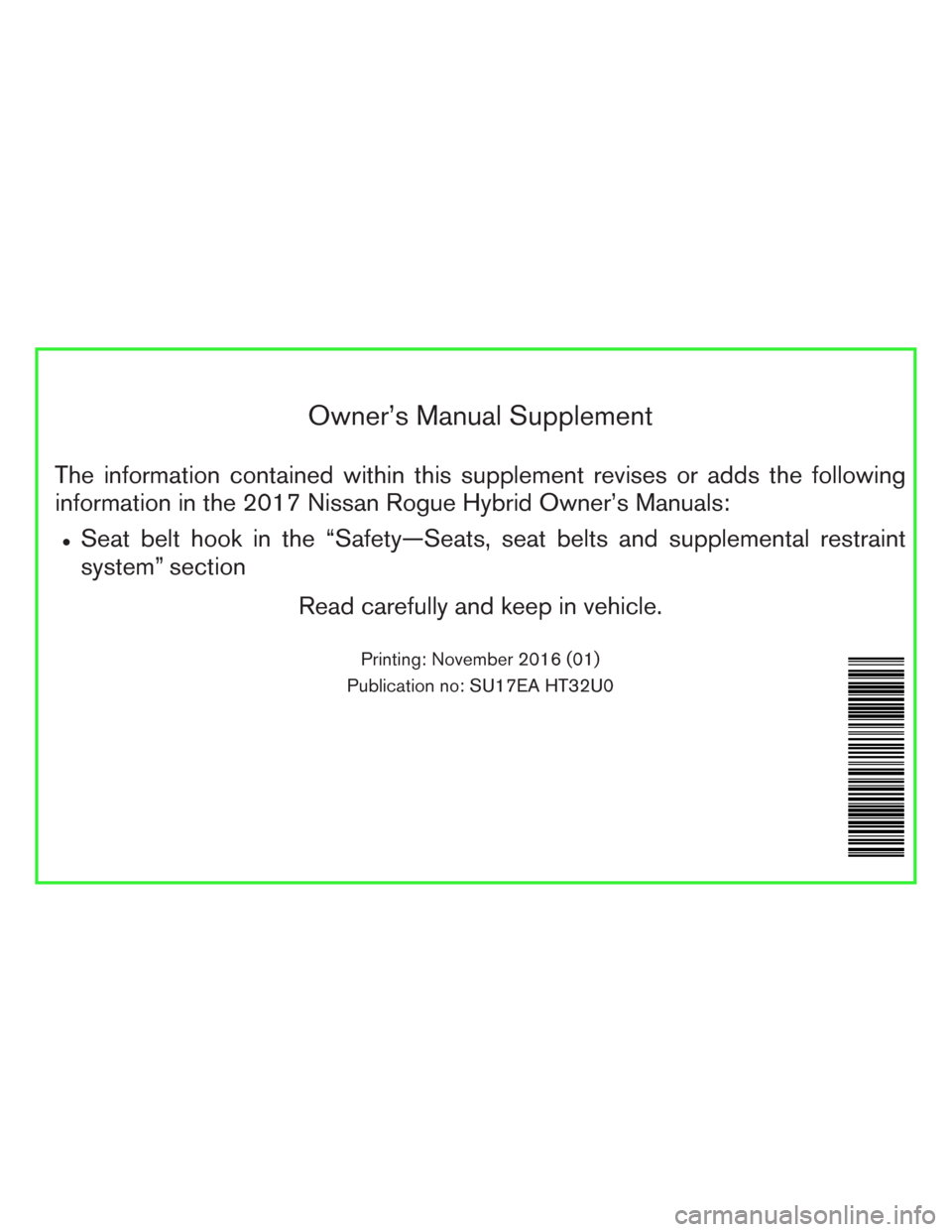
Owner’s Manual Supplement
The information contained within this supplement revises or adds the following
information in the 2017 Nissan Rogue Hybrid Owner’s Manuals:
●Seat belt hook in the “Safety—Seats, seat belts and supplemental restraint
system” section
Read carefully and keep in vehicle.
Printing: November 2016 (01)
Publication no: SU17EA HT32U0
Page 3 of 520
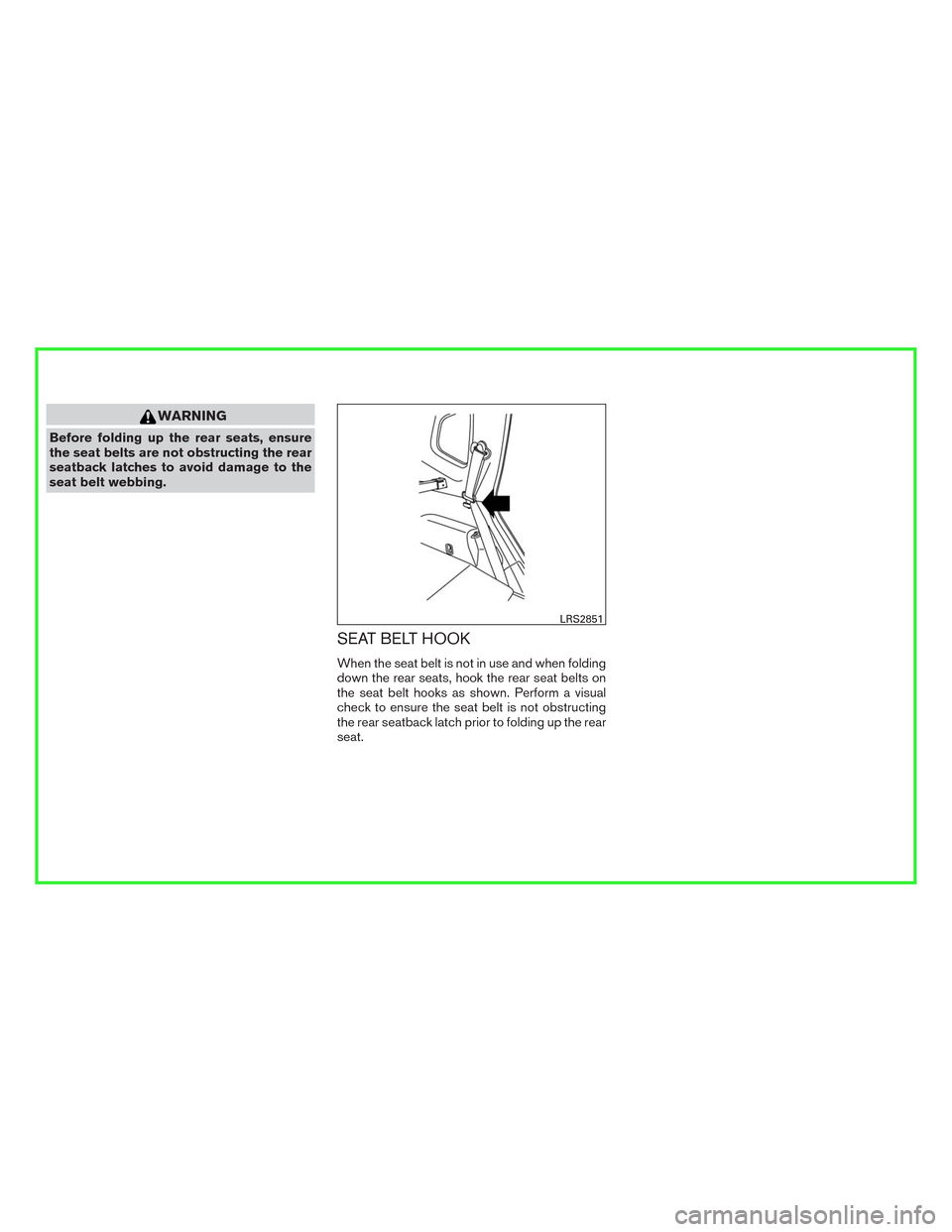
WARNING
Before folding up the rear seats, ensure
the seat belts are not obstructing the rear
seatback latches to avoid damage to the
seat belt webbing.
SEAT BELT HOOK
When the seat belt is not in use and when folding
down the rear seats, hook the rear seat belts on
the seat belt hooks as shown. Perform a visual
check to ensure the seat belt is not obstructing
the rear seatback latch prior to folding up the rear
seat.
LRS2851
Page 4 of 520
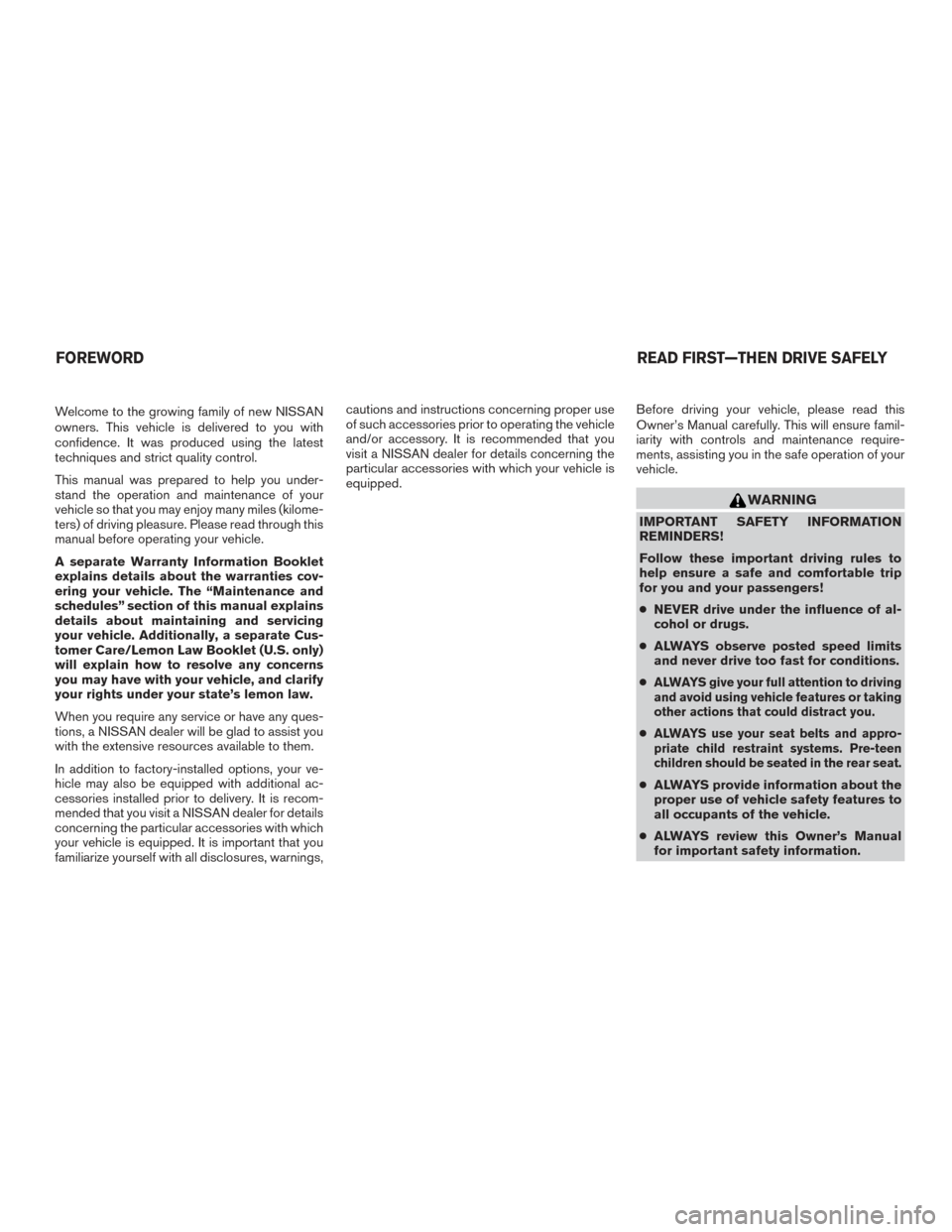
Welcome to the growing family of new NISSAN
owners. This vehicle is delivered to you with
confidence. It was produced using the latest
techniques and strict quality control.
This manual was prepared to help you under-
stand the operation and maintenance of your
vehicle so that you may enjoy many miles (kilome-
ters) of driving pleasure. Please read through this
manual before operating your vehicle.
A separate Warranty Information Booklet
explains details about the warranties cov-
ering your vehicle. The “Maintenance and
schedules” section of this manual explains
details about maintaining and servicing
your vehicle. Additionally, a separate Cus-
tomer Care/Lemon Law Booklet (U.S. only)
will explain how to resolve any concerns
you may have with your vehicle, and clarify
your rights under your state’s lemon law.
When you require any service or have any ques-
tions, a NISSAN dealer will be glad to assist you
with the extensive resources available to them.
In addition to factory-installed options, your ve-
hicle may also be equipped with additional ac-
cessories installed prior to delivery. It is recom-
mended that you visit a NISSAN dealer for details
concerning the particular accessories with which
your vehicle is equipped. It is important that you
familiarize yourself with all disclosures, warnings,cautions and instructions concerning proper use
of such accessories prior to operating the vehicle
and/or accessory. It is recommended that you
visit a NISSAN dealer for details concerning the
particular accessories with which your vehicle is
equipped.
Before driving your vehicle, please read this
Owner’s Manual carefully. This will ensure famil-
iarity with controls and maintenance require-
ments, assisting you in the safe operation of your
vehicle.
WARNING
IMPORTANT SAFETY INFORMATION
REMINDERS!
Follow these important driving rules to
help ensure a safe and comfortable trip
for you and your passengers!
●
NEVER drive under the influence of al-
cohol or drugs.
● ALWAYS observe posted speed limits
and never drive too fast for conditions.
●
ALWAYS give your full attention to driving
and avoid using vehicle features or taking
other actions that could distract you.
●ALWAYS use your seat belts and appro-
priate child restraint systems. Pre-teen
children should be seated in the rear seat.
● ALWAYS provide information about the
proper use of vehicle safety features to
all occupants of the vehicle.
● ALWAYS review this Owner’s Manual
for important safety information.
FOREWORD READ FIRST—THEN DRIVE SAFELY
Page 10 of 520
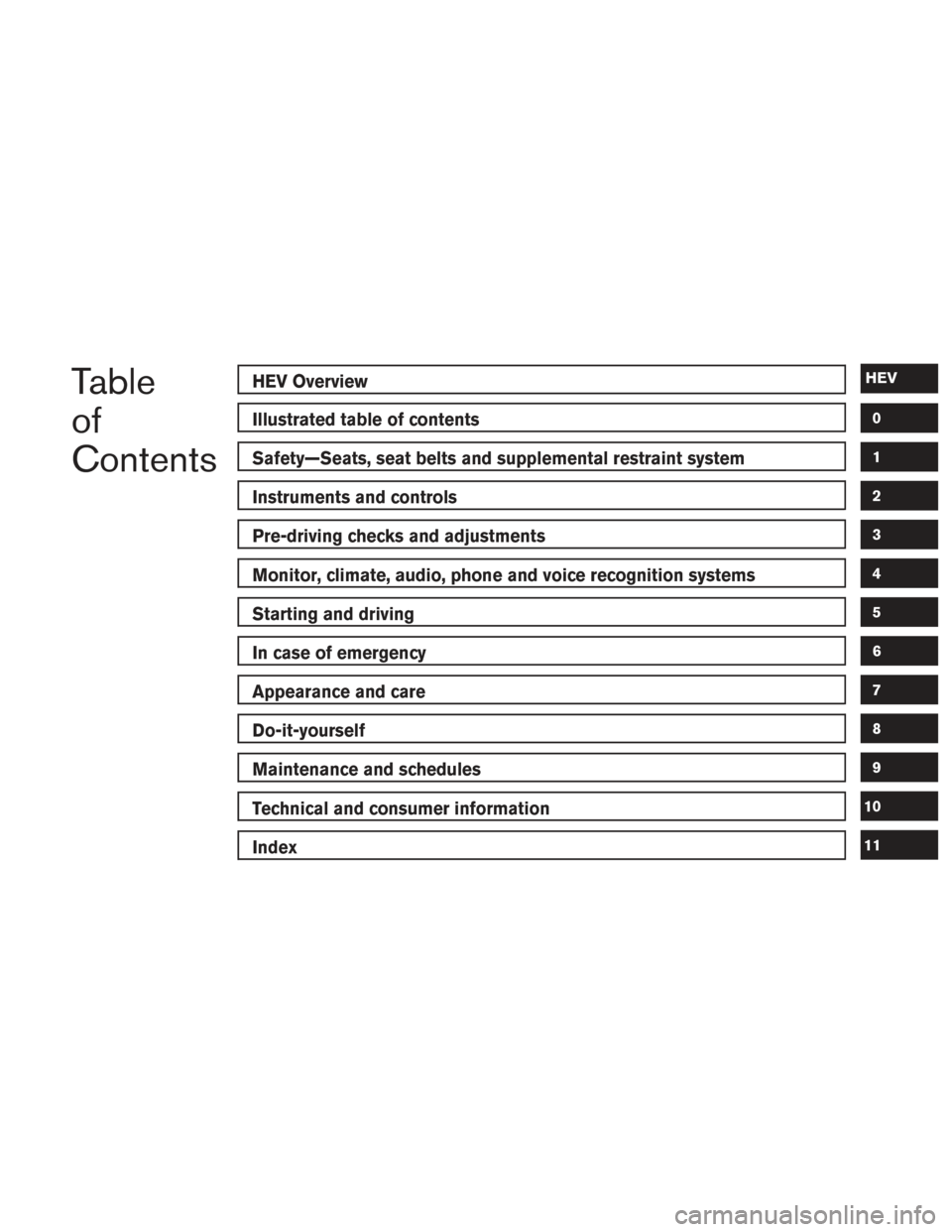
Table
of
ContentsHEV Overview
Illustrated table of contents
Safety—Seats, seat belts and supplemental restraint system
Instruments and controls
Pre-driving checks and adjustments
Monitor, climate, audio, phone and voice recognition systems
Starting and driving
In case of emergency
Appearance and care
Do-it-yourself
Maintenance and schedules
Technical and consumer information
Index
HEV
0
1
2
3
4
5
6
7
8
9
10
11
Page 16 of 520
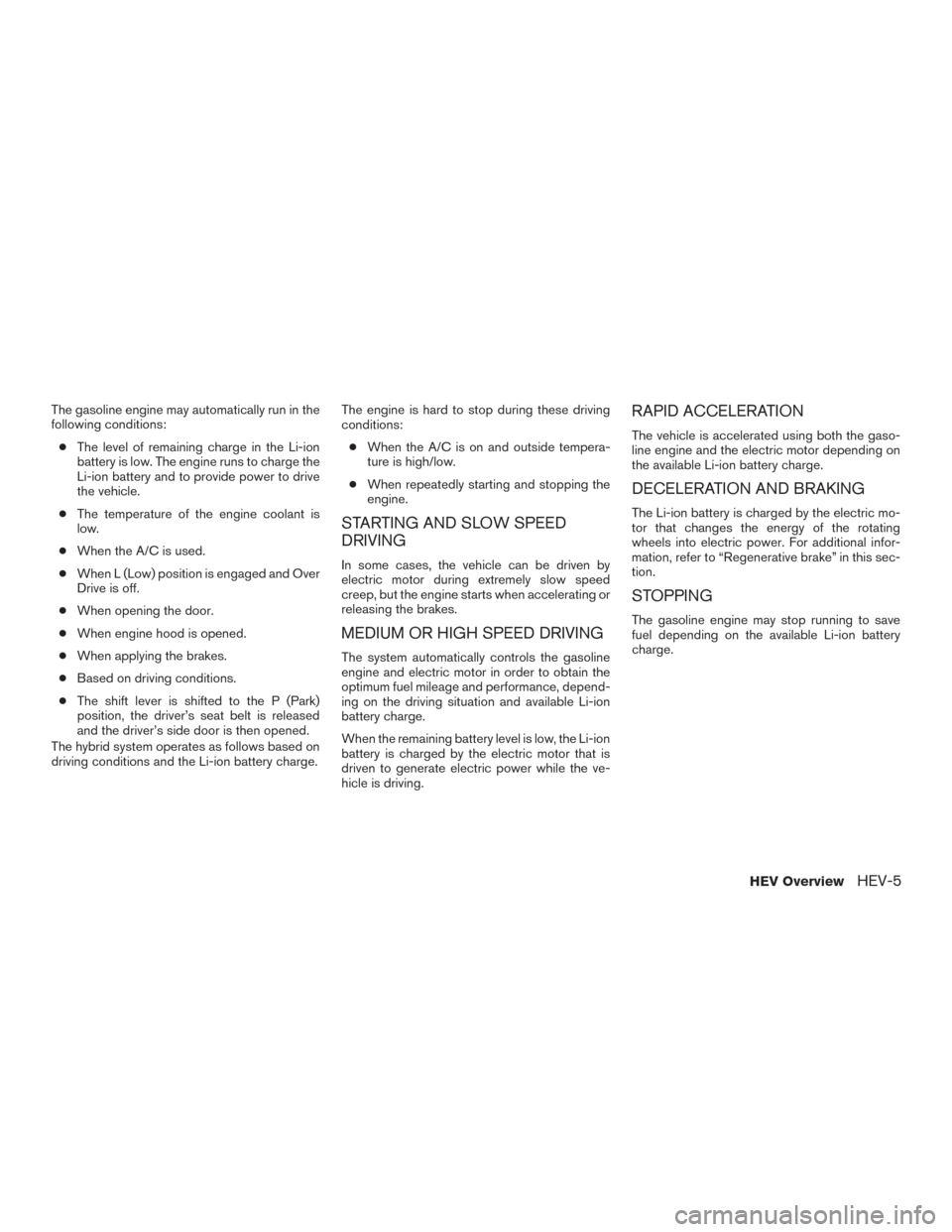
The gasoline engine may automatically run in the
following conditions:● The level of remaining charge in the Li-ion
battery is low. The engine runs to charge the
Li-ion battery and to provide power to drive
the vehicle.
● The temperature of the engine coolant is
low.
● When the A/C is used.
● When L (Low) position is engaged and Over
Drive is off.
● When opening the door.
● When engine hood is opened.
● When applying the brakes.
● Based on driving conditions.
● The shift lever is shifted to the P (Park)
position, the driver’s seat belt is released
and the driver’s side door is then opened.
The hybrid system operates as follows based on
driving conditions and the Li-ion battery charge. The engine is hard to stop during these driving
conditions:
● When the A/C is on and outside tempera-
ture is high/low.
● When repeatedly starting and stopping the
engine.
STARTING AND SLOW SPEED
DRIVING
In some cases, the vehicle can be driven by
electric motor during extremely slow speed
creep, but the engine starts when accelerating or
releasing the brakes.
MEDIUM OR HIGH SPEED DRIVING
The system automatically controls the gasoline
engine and electric motor in order to obtain the
optimum fuel mileage and performance, depend-
ing on the driving situation and available Li-ion
battery charge.
When the remaining battery level is low, the Li-ion
battery is charged by the electric motor that is
driven to generate electric power while the ve-
hicle is driving.
RAPID ACCELERATION
The vehicle is accelerated using both the gaso-
line engine and the electric motor depending on
the available Li-ion battery charge.
DECELERATION AND BRAKING
The Li-ion battery is charged by the electric mo-
tor that changes the energy of the rotating
wheels into electric power. For additional infor-
mation, refer to “Regenerative brake” in this sec-
tion.
STOPPING
The gasoline engine may stop running to save
fuel depending on the available Li-ion battery
charge.
HEV OverviewHEV-5
Page 28 of 520
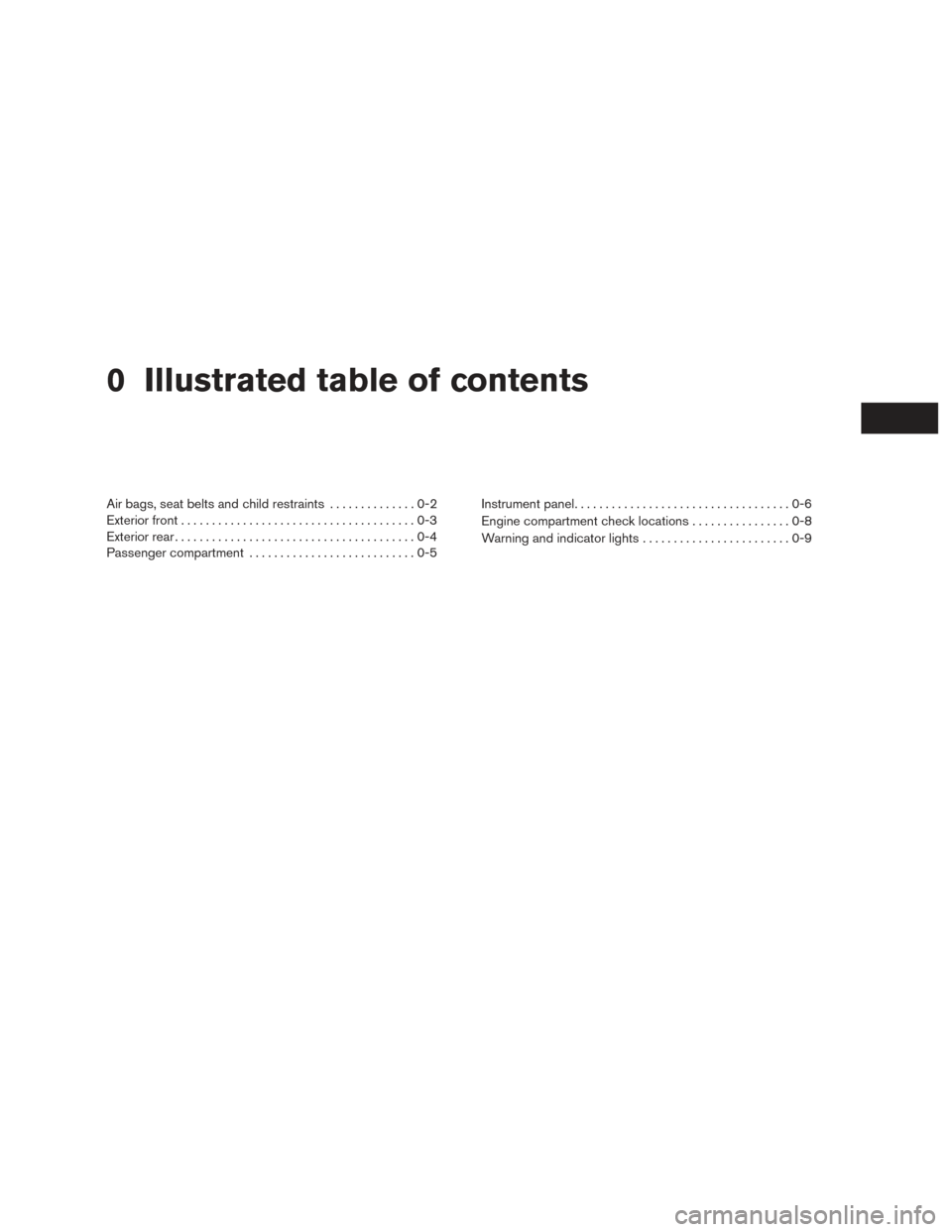
0 Illustrated table of contents
Air bags, seat belts and child restraints..............0-2
Exterior front ......................................0-3
Exterior rear .......................................0-4
Passenger compartment ...........................0-5 Instrument panel
...................................0-6
Engine compartment check locations . . ..............0-8
Warning and indicator lights ........................0-9
Page 29 of 520
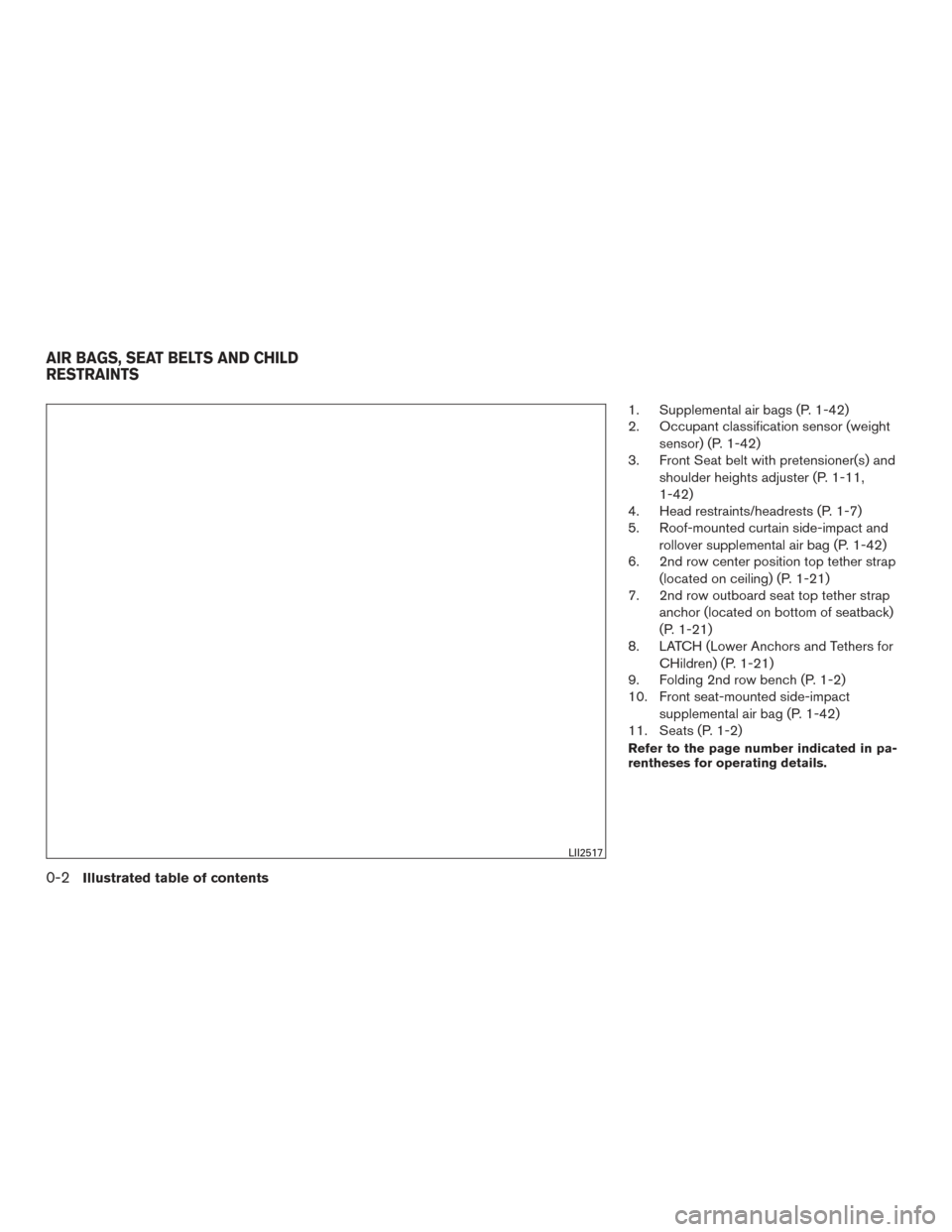
1. Supplemental air bags (P. 1-42)
2. Occupant classification sensor (weightsensor) (P. 1-42)
3. Front Seat belt with pretensioner(s) and
shoulder heights adjuster (P. 1-11,
1-42)
4. Head restraints/headrests (P. 1-7)
5. Roof-mounted curtain side-impact and
rollover supplemental air bag (P. 1-42)
6. 2nd row center position top tether strap
(located on ceiling) (P. 1-21)
7. 2nd row outboard seat top tether strap
anchor (located on bottom of seatback)
(P. 1-21)
8. LATCH (Lower Anchors and Tethers for
CHildren) (P. 1-21)
9. Folding 2nd row bench (P. 1-2)
10. Front seat-mounted side-impact
supplemental air bag (P. 1-42)
11. Seats (P. 1-2)
Refer to the page number indicated in pa-
rentheses for operating details.
LII2517
AIR BAGS, SEAT BELTS AND CHILD
RESTRAINTS
0-2Illustrated table of contents
Page 36 of 520
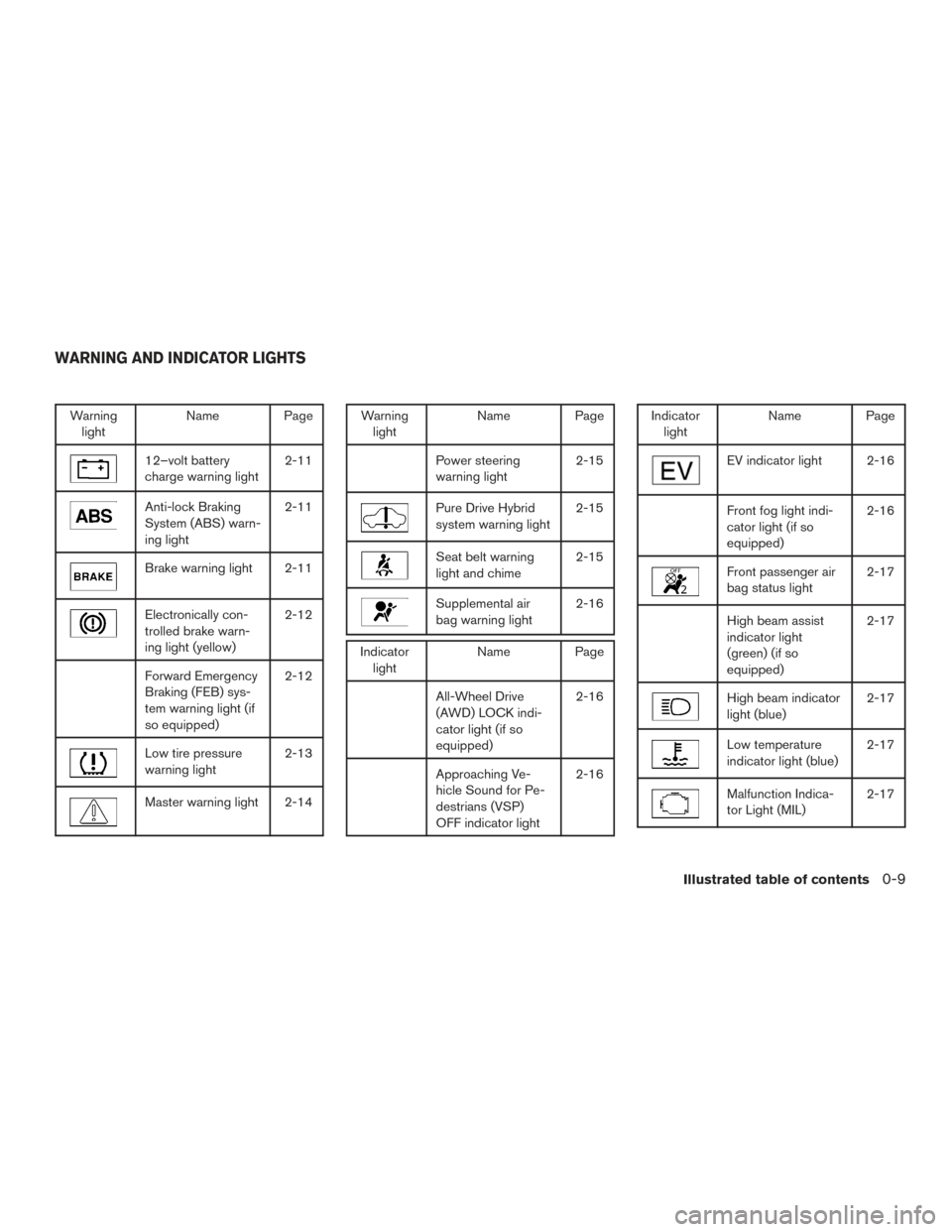
Warninglight Name Page
12–volt battery
charge warning light 2-11
Anti-lock Braking
System (ABS) warn-
ing light2-11
Brake warning light 2-11
Electronically con-
trolled brake warn-
ing light (yellow)2-12
Forward Emergency
Braking (FEB) sys-
tem warning light (if
so equipped)2-12
Low tire pressure
warning light
2-13
Master warning light 2-14
Warning
light Name Page
Power steering
warning light 2-15
Pure Drive Hybrid
system warning light2-15
Seat belt warning
light and chime2-15
Supplemental air
bag warning light2-16
Indicator
light Name Page
All-Wheel Drive
(AWD) LOCK indi-
cator light (if so
equipped) 2-16
Approaching Ve-
hicle Sound for Pe-
destrians (VSP)
OFF indicator light2-16
Indicator
light Name Page
EV indicator light 2-16
Front fog light indi-
cator light (if so
equipped) 2-16
Front passenger air
bag status light
2-17
High beam assist
indicator light
(green) (if so
equipped)2-17
High beam indicator
light (blue)
2-17
Low temperature
indicator light (blue)2-17
Malfunction Indica-
tor Light (MIL)2-17
WARNING AND INDICATOR LIGHTS
Illustrated table of contents0-9
Page 38 of 520
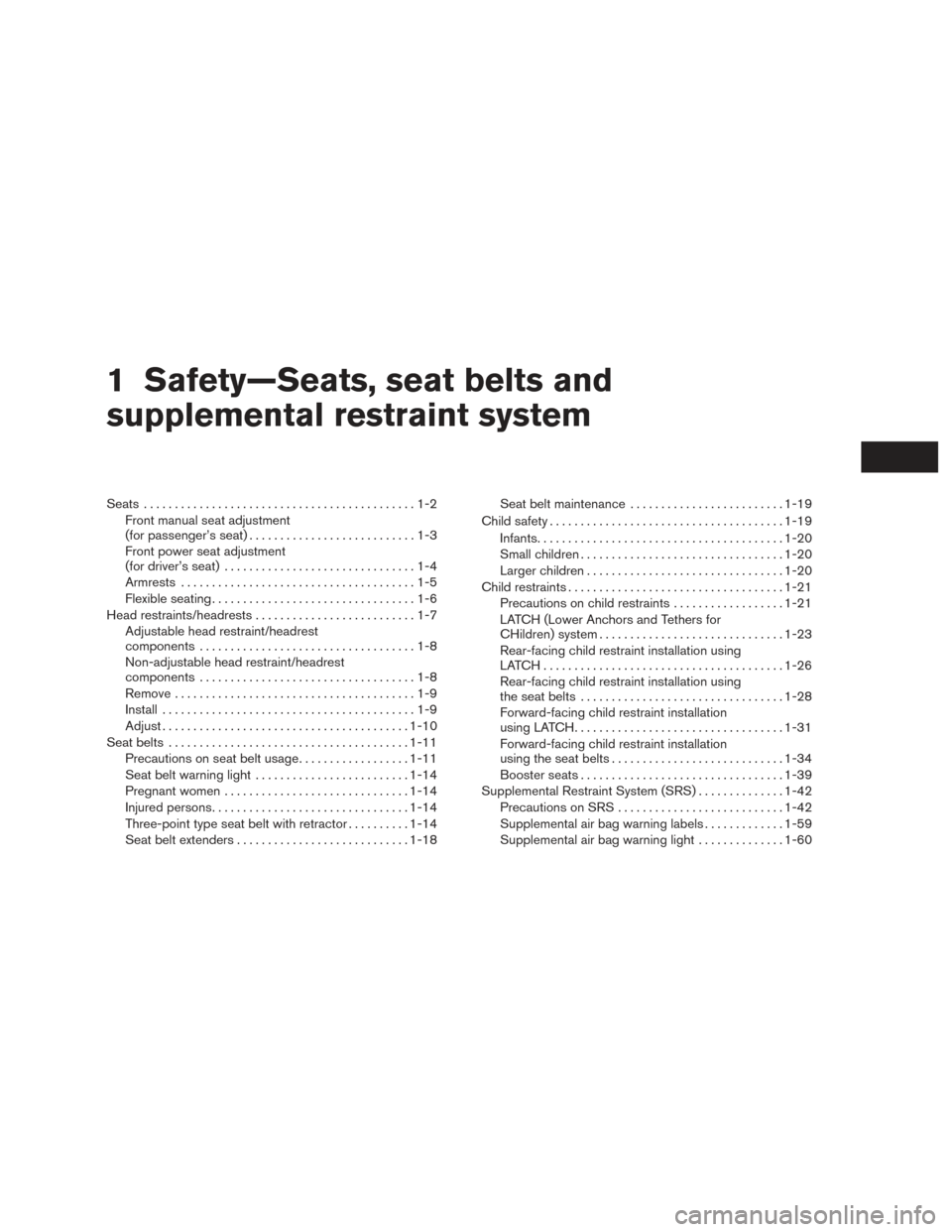
1 Safety—Seats, seat belts and
supplemental restraint system
Seats............................................1-2
Front manual seat adjustment
(for passenger’s seat) ...........................1-3
Front power seat adjustment
(for driver’s seat) ...............................1-4
Armrests ......................................1-5
Flexible seating .................................1-6
Head restraints/headrests ..........................1-7
Adjustable head restraint/headrest
components ...................................1-8
Non-adjustable head restraint/headrest
components ...................................1-8
Remove .......................................1-9
Install .........................................1-9
Adjust ........................................ 1-10
Seat belts ....................................... 1-11
Precautions on seat belt usage ..................1-11
Seat belt warning light ......................... 1-14
Pregnant women .............................. 1-14
Injured persons ................................ 1-14
Three-point type seat belt with retractor ..........1-14
Seat belt extenders ............................ 1-18Seat belt maintenance
......................... 1-19
Child safety ...................................... 1-19
Infants ........................................ 1-20
Small children ................................. 1-20
Larger children ................................ 1-20
Child restraints ................................... 1-21
Precautions on child restraints ..................1-21
LATCH (Lower Anchors and Tethers for
CHildren) system .............................. 1-23
Rear-facing child restraint installation using
LATCH....................................... 1-26
Rear-facing child restraint installation using
the seat belts ................................. 1-28
Forward-facing child restraint installation
using LATCH .................................. 1-31
Forward-facing child restraint installation
using the seat belts ............................ 1-34
Booster seats ................................. 1-39
Supplemental Restraint System (SRS) ..............1-42
Precautions on SRS ........................... 1-42
Supplemental air bag warning labels .............1-59
Supplemental air bag warning light ..............1-60
Page 39 of 520
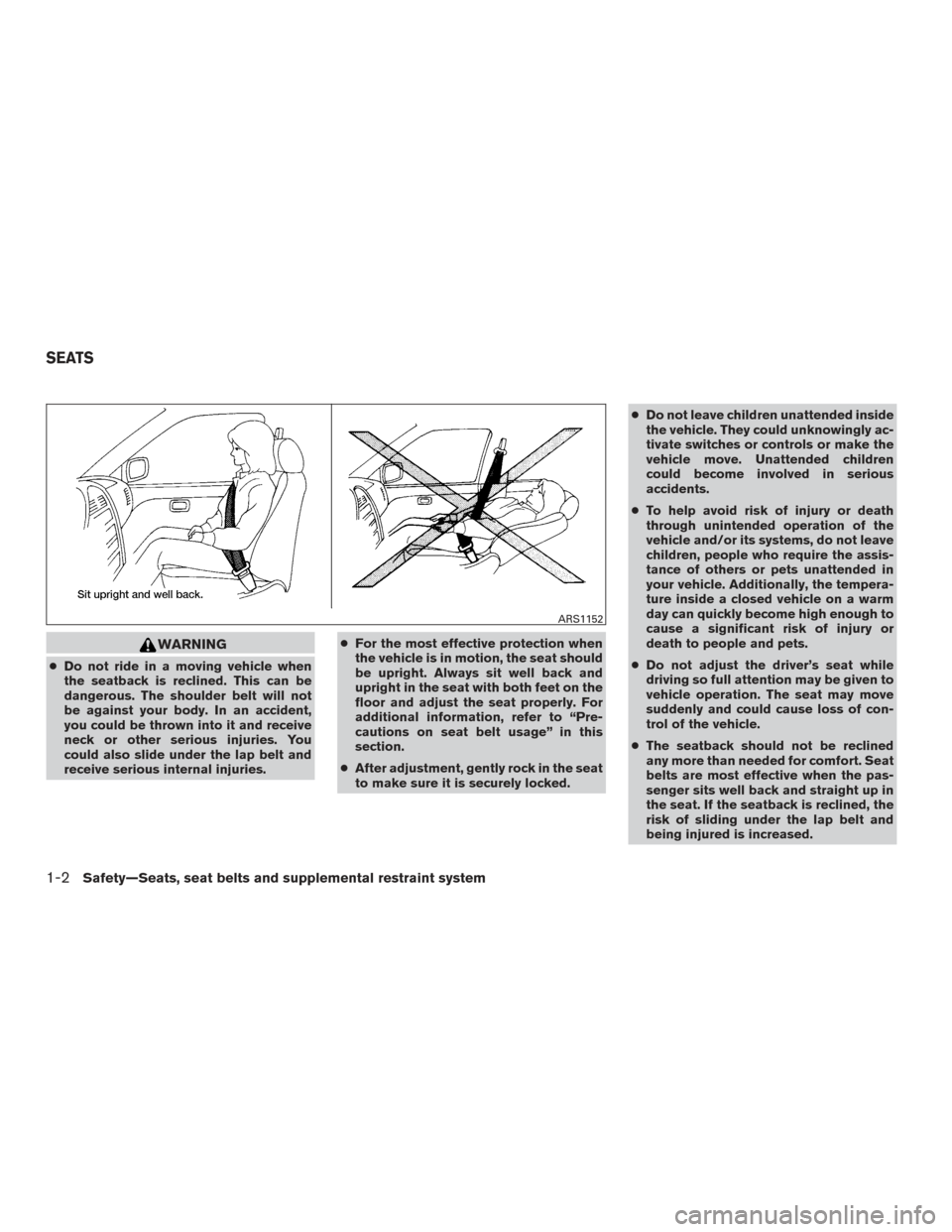
WARNING
●Do not ride in a moving vehicle when
the seatback is reclined. This can be
dangerous. The shoulder belt will not
be against your body. In an accident,
you could be thrown into it and receive
neck or other serious injuries. You
could also slide under the lap belt and
receive serious internal injuries. ●
For the most effective protection when
the vehicle is in motion, the seat should
be upright. Always sit well back and
upright in the seat with both feet on the
floor and adjust the seat properly. For
additional information, refer to “Pre-
cautions on seat belt usage” in this
section.
● After adjustment, gently rock in the seat
to make sure it is securely locked. ●
Do not leave children unattended inside
the vehicle. They could unknowingly ac-
tivate switches or controls or make the
vehicle move. Unattended children
could become involved in serious
accidents.
● To help avoid risk of injury or death
through unintended operation of the
vehicle and/or its systems, do not leave
children, people who require the assis-
tance of others or pets unattended in
your vehicle. Additionally, the tempera-
ture inside a closed vehicle on a warm
day can quickly become high enough to
cause a significant risk of injury or
death to people and pets.
● Do not adjust the driver’s seat while
driving so full attention may be given to
vehicle operation. The seat may move
suddenly and could cause loss of con-
trol of the vehicle.
● The seatback should not be reclined
any more than needed for comfort. Seat
belts are most effective when the pas-
senger sits well back and straight up in
the seat. If the seatback is reclined, the
risk of sliding under the lap belt and
being injured is increased.
ARS1152
SEATS
1-2Safety—Seats, seat belts and supplemental restraint system